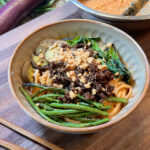Kinilaw is a tangy and bright Filipino dish consisting of raw fish “cooked” with citrus and vinegar. With no heat involved, it’s incredibly simple to prepare and is the perfect appetizer or snack to be shared!
What is kinilaw?
“Kinilaw” literally means to be “eaten raw”, which is a traditional Filipino dish dating back to the pre-colonial eras. It essentially consists of cubed or thinly-sliced fish that’s tossed with vinegar, citrus juice, and other vegetables.
The acids help to “cook” the raw fish, and you’ll notice the texture and appearance of the fish change when that chemical reaction occurs.
While the dish was originally prepared by Indigenous Filipinos as a way to preserve fresh seafood with salt and acid, it is now a popular snack or appetizer amongst locals, also known as “pulutan”. Pulutan refers to any Filipino dish made to be served in bars as a quick meal, which is also accompanied by some kind of alcoholic drink (mainly beer).

It’s fresh, tangy, and light, so be sure to use the freshest seafood you can find.
Looking to explore more delicious Filipino food? Try out some of these similar recipes:
- Crispy Tofu Sisig (Tofu Stirfry)
- Spicy Chicken Adobo
- Chili Garlic Sinangag (Fried Rice)
- Filipino Mango Salad
Ingredients for kinilaw
Serves: 2-3
- ~255 g basa fillets, cut into thin strips or 1-inch cubes
- ~1 cup vinegar, for marinating
- 1/2 cup red onion, julienned (~1/2 small red onion)
- 1 tbsp ginger, julienned
- 1/4 cup cucumber, thinly chopped
- 1/4 cup roma tomato, julienned (1/2 tomato)
- 1/2 tbsp cilantro stems, chopped
- 1-2 Thai chillies, chopped
- 2 tbsp vinegar (cane or coconut vinegar work best here)
- 2 tbsp citrus juice (calamansi, lime, or lemon)
- 1/2 tsp salt, to taste
- 1/4 tsp ground black pepper, to taste
- 1 tbsp coconut cream (or coconut milk)

Fish to use
There is an abundance of fish that can be used to prepare kinilaw. Try to go for fish that tend to have fleshy, firm meat such as:
- Basa: this is the standard fish I typically use for Kinilaw due to its firm texture and light fish flavor.
- Tuna
- Mackerel
- Sea bass
- Grouper
- Sword fish
- Anchovies
If you want a little variation, Kinilaw can also work with other seafood apart from fish! Seafoods like scallops, oysters, clams, crab, and shrimp work perfectly for this recipe as well.
Vinegars/Acids
Kinilaw uses a mixture of citrus and vinegar to marinate the fish.
For citrus, I’d recommend going for calamansi or lime juice. Lemon juice can also work.
As for vinegars, the two most popular vinegars used for this dish are either coconut vinegar or cane vinegar. Coconut vinegar would be preferred since it’s what was used traditionally for this dish, but cane vinegar is also fine to use (and is more accessible!)
Instructions for kinilaw
Prepare the fish by either slicing it into thin strips or cutting it into 1-inch cubes. Place it into a bowl and pour in the 1 cup of vinegar which should just be enough to submerge the fish. Massage the fish gently with the vinegar, then let it soak for 15 minutes. After 15 minutes, drain the vinegar and set the fish aside.
(You can start to prepare the veggies while the fish is soaking)


In a bowl, combine together the 2 tbsp of vinegar, citrus juice, coconut cream, salt, and pepper. Mix thoroughly until well combined.

Add in the onion, ginger, cucumber, tomato, cilantro stems, Thai chilies, and the vinegar-soaked fish. Stir gently to combine, then cover with plastic wrap. Let this marinate for at least 30 minutes up to an hour to continue “cooking” the fish.


Serve and enjoy with an ice-cold drink!

How to serve
Kinilaw is best prepared and served on the same day. You’d typically want to serve this within 1-2 hours of preparing the dish in order to maximize it’s freshness and ideal textures of the fish. Any longer, and the acids can start to “overcook” the fish, causing it to become tough, dry, and break apart in the marinade.
Kinilaw is meant to be a light snack or appetizer, so treat it as you would bar food, accompanying a much bigger meal and with a side of cold beverages.
Nowadays, Kinilaw has become more popular in the way it’s prepared and eaten. I’ve begun to see people eat this with rice (similar to Hawaiian poke), with tortillas (like with Peruvian ceviche), or even with chips to utilize their contrasting textures.
Disclosure: Some links on this page are affiliate links, meaning that at no additional cost to you, we may receive compensation from purchases made through these links. As an Amazon Associate, I can earn from qualifying purchases.







